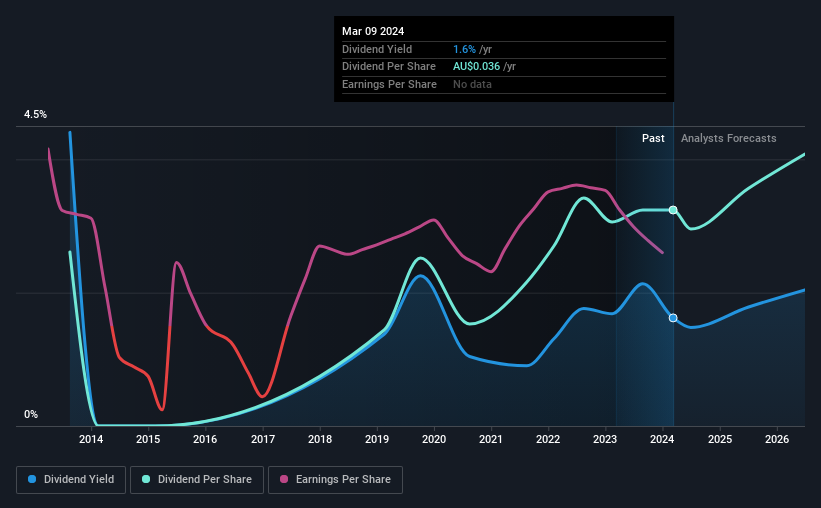Only Three Days Left To Cash In On Imdex's (ASX:IMD) Dividend
Regular readers will know that we love our dividends at Simply Wall St, which is why it's exciting to see Imdex Limited (ASX:IMD) is about to trade ex-dividend in the next 3 days. The ex-dividend date is one business day before the record date, which is the cut-off date for shareholders to be present on the company's books to be eligible for a dividend payment. The ex-dividend date is an important date to be aware of as any purchase of the stock made on or after this date might mean a late settlement that doesn't show on the record date. In other words, investors can purchase Imdex's shares before the 13th of March in order to be eligible for the dividend, which will be paid on the 28th of March.
The company's next dividend payment will be AU$0.015 per share. Last year, in total, the company distributed AU$0.036 to shareholders. Based on the last year's worth of payments, Imdex has a trailing yield of 1.6% on the current stock price of AU$2.22. We love seeing companies pay a dividend, but it's also important to be sure that laying the golden eggs isn't going to kill our golden goose! As a result, readers should always check whether Imdex has been able to grow its dividends, or if the dividend might be cut.
Check out our latest analysis for Imdex
Dividends are typically paid from company earnings. If a company pays more in dividends than it earned in profit, then the dividend could be unsustainable. Imdex paid out 61% of its earnings to investors last year, a normal payout level for most businesses. Yet cash flow is typically more important than profit for assessing dividend sustainability, so we should always check if the company generated enough cash to afford its dividend. It distributed 26% of its free cash flow as dividends, a comfortable payout level for most companies.
It's encouraging to see that the dividend is covered by both profit and cash flow. This generally suggests the dividend is sustainable, as long as earnings don't drop precipitously.
Click here to see the company's payout ratio, plus analyst estimates of its future dividends.
Have Earnings And Dividends Been Growing?
Stocks with flat earnings can still be attractive dividend payers, but it is important to be more conservative with your approach and demand a greater margin for safety when it comes to dividend sustainability. If earnings fall far enough, the company could be forced to cut its dividend. With that in mind, we're not enthused to see that Imdex's earnings per share have remained effectively flat over the past five years. Better than seeing them fall off a cliff, for sure, but the best dividend stocks grow their earnings meaningfully over the long run.
Imdex also issued more than 5% of its market cap in new stock during the past year, which we feel is likely to hurt its dividend prospects in the long run. Trying to grow the dividend while issuing large amounts of new shares reminds us of the ancient Greek tale of Sisyphus - perpetually pushing a boulder uphill.
Another key way to measure a company's dividend prospects is by measuring its historical rate of dividend growth. Imdex has delivered an average of 2.2% per year annual increase in its dividend, based on the past 10 years of dividend payments.
The Bottom Line
Is Imdex an attractive dividend stock, or better left on the shelf? The payout ratios appear reasonably conservative, which implies the dividend may be somewhat sustainable. Still, with earnings basically flat, Imdex doesn't stand out from a dividend perspective. In summary, it's hard to get excited about Imdex from a dividend perspective.
If you're not too concerned about Imdex's ability to pay dividends, you should still be mindful of some of the other risks that this business faces. Every company has risks, and we've spotted 1 warning sign for Imdex you should know about.
If you're in the market for strong dividend payers, we recommend checking our selection of top dividend stocks.
Have feedback on this article? Concerned about the content? Get in touch with us directly. Alternatively, email editorial-team (at) simplywallst.com.
This article by Simply Wall St is general in nature. We provide commentary based on historical data and analyst forecasts only using an unbiased methodology and our articles are not intended to be financial advice. It does not constitute a recommendation to buy or sell any stock, and does not take account of your objectives, or your financial situation. We aim to bring you long-term focused analysis driven by fundamental data. Note that our analysis may not factor in the latest price-sensitive company announcements or qualitative material. Simply Wall St has no position in any stocks mentioned.

